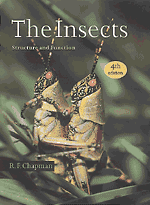Book contents
- Frontmatter
- Contents
- Preface
- Acknowledgments
- PART I The Head, Ingestion, Utilization and Distribution of Food
- PART II The Thorax and Locomotion
- PART III The Abdomen, Reproduction and Development
- PART IV The Integument, Gas Exchange and Homeostasis
- PART V Communication
- 20 Nervous system
- 21 Endocrine system
- 22 Vision
- 23 Mechanoreception
- 24 Chemoreception
- 25 Visual signals: color and light production
- 26 Mechanical communication: producing sound and substrate vibrations
- 27 Chemical communication: pheromones and chemicals with interspecific significance
- Taxonomic index
- Subject index
27 - Chemical communication: pheromones and chemicals with interspecific significance
Published online by Cambridge University Press: 05 June 2012
- Frontmatter
- Contents
- Preface
- Acknowledgments
- PART I The Head, Ingestion, Utilization and Distribution of Food
- PART II The Thorax and Locomotion
- PART III The Abdomen, Reproduction and Development
- PART IV The Integument, Gas Exchange and Homeostasis
- PART V Communication
- 20 Nervous system
- 21 Endocrine system
- 22 Vision
- 23 Mechanoreception
- 24 Chemoreception
- 25 Visual signals: color and light production
- 26 Mechanical communication: producing sound and substrate vibrations
- 27 Chemical communication: pheromones and chemicals with interspecific significance
- Taxonomic index
- Subject index
Summary
Hormones are concerned with regulation within the organism. Other chemical substances are concerned with communication between organisms, both intra- and interspecifically. Chemicals with an intraspecific function are called pheromones; those with an interspecific function are often called allelochemicals. Some chemicals can serve both functions, even in one insect (Blum, 1996). Most pheromones and allelochemicals are produced by ectodermal glands secreting to the outside of the body. The basic structure of these exocrine glands is similar irrespective of whether they produce pheromones or allelochemicals, but their positions on the body and the chemicals they produce exhibit extraordinary diversity. Glands producing chemicals for interspecific communications usually have reservoirs while most pheromone glands do not. Pheromones used for marking, however, are usually stored in a reservoir. Many chemicals used for defense are stored within the body and are not secreted.
PHEROMONES
A pheromone is a secretion which, if passed to another individual of the same species, causes it to respond, physiologically or behaviorally, in a particular manner. Pheromones are thus concerned with signalling between individuals of the same species and are therefore often important in sexual behavior and in regulating the behavior and physiology of social and subsocial species. It is probably true that pheromones are used in communication by at least some species in all the insect orders.
Many pheromones are perceived as scents by olfactory receptors and affect the recipient via the central nervous system. In other cases, pheromones are ingested by the recipient.
- Type
- Chapter
- Information
- The InsectsStructure and Function, pp. 704 - 740Publisher: Cambridge University PressPrint publication year: 1998



